Your Which of the following processes is an example of a post translational modification images are available in this site. Which of the following processes is an example of a post translational modification are a topic that is being searched for and liked by netizens today. You can Download the Which of the following processes is an example of a post translational modification files here. Download all royalty-free photos and vectors.
If you’re looking for which of the following processes is an example of a post translational modification pictures information connected with to the which of the following processes is an example of a post translational modification keyword, you have come to the right site. Our website always gives you hints for seeing the maximum quality video and image content, please kindly hunt and find more enlightening video content and graphics that match your interests.
Which Of The Following Processes Is An Example Of A Post Translational Modification. Post-translational modification can occur at any step in the life cycle of a protein. Examples are zymogens which are inactive forms of enzymes and are activated by the removal of some portion of the protein. Which of the following processes is an example of posttranslational modification of protein. Other proteins will be glycosylated - a sugar will be added.
 Gene Structure And Gene Expression In Higher Organisms Molecular Genetics Gene Expression Teaching Biology From pinterest.com
Gene Structure And Gene Expression In Higher Organisms Molecular Genetics Gene Expression Teaching Biology From pinterest.com
Proteolytic cleavage is one of the common modifications where proteins are cleaved to remove some additional amino acids or portion of protein. Other proteins will be glycosylated - a sugar will be added. PTMs are important components in cell signaling as for example when prohormones are converted to hormones. Click card to see definition. A proteosome recognizes a ubiquitin molecule and degrades the protein molecule to which it is attached. Here is the answer for the question Which of the following processes is an example of a post-translational modification.
Formation of disulfide bonds.
Another common post-translational modification is cleavage or linking of parts of the protein itself. SRP receptor Site on the rough ER membrane that binds the SRPsynthesizing ribosome complex and moves it to a translocon gate which forces the ribosome to synthesize the rest of the protein into the lumen of the rough ER. Post-translational modification PTM refers to the covalent and generally enzymatic modification of proteins following protein biosynthesis. Deactivation of initiation factors. Answer Trivia - VQB 122320 Answer Which of the following processes is an example of a post-translational modification. QUESTION 12 Which of the following is not an example of posttranslational modification.
 Source: pinterest.com
Source: pinterest.com
Answer Which of the following processes is an example of a post-translational modification. Which of the following is an example of a posttranslational control. Post-translational modification can occur at any step in the life cycle of a protein. Post-translational modification PTM refers to the covalent and generally enzymatic modification of proteins following protein biosynthesisProteins are synthesized by ribosomes translating mRNA into polypeptide chains which may then undergo PTM to form the mature protein product. Another common post-translational modification is cleavage or linking of parts of the protein itself.
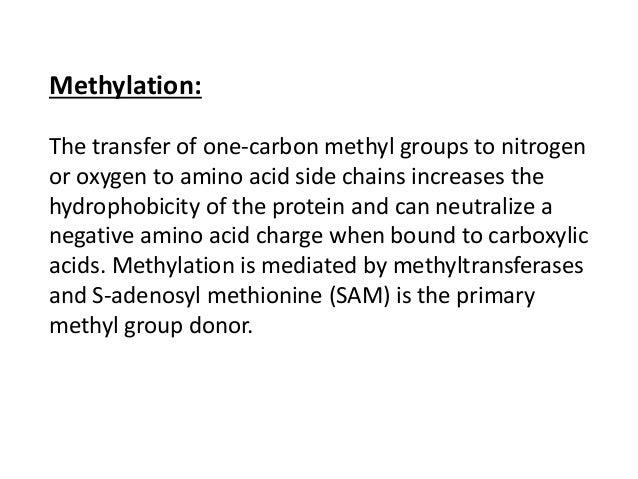 Source: slideshare.net
Source: slideshare.net
Answer Trivia - VQB 122320 Answer Which of the following processes is an example of a post-translational modification. Here is the answer for the question Which of the following processes is an example of a post-translational modification. PTMs are important components in cell signaling as for example when prohormones are converted to hormones. Youll find the correct answer below Which of the following processes is an example of a post-translational modification. Deactivation of initiation factors.
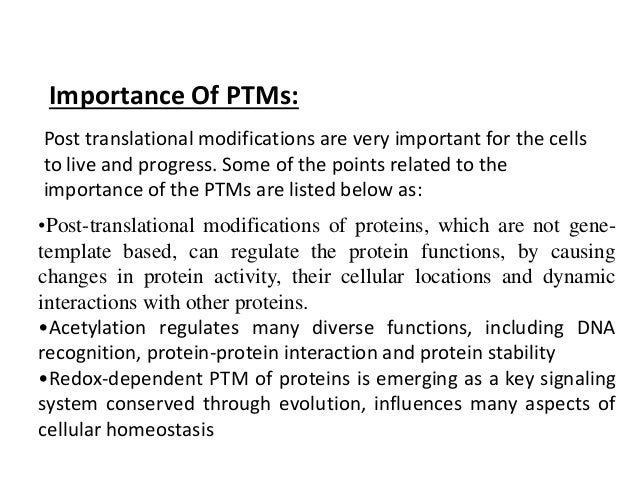 Source: slideshare.net
Source: slideshare.net
O N-myristylation O Prenylation O GPI anchor addition Glycosylation. Which of the following processes is an example of a post-translational modification. QUESTION 12 Which of the following is not an example of posttranslational modification. Common modifications include phosphate groups methyl acetate and amide groups. Another common post-translational modification is cleavage or linking of parts of the protein itself.
 Source: pinterest.com
Source: pinterest.com
O N-myristylation O Prenylation O GPI anchor addition Glycosylation. Post-translational modification PTM refers to the covalent and generally enzymatic modification of proteins following protein biosynthesisProteins are synthesized by ribosomes translating mRNA into polypeptide chains which may then undergo PTM to form the mature protein product. An activator binds to an enhancer. Proteins are synthesized by ribosomes translating mRNA into polypeptide chains which may then undergo PTM to form the mature protein product. Youll find the correct answer below Which of the following processes is an example of a post-translational modification.
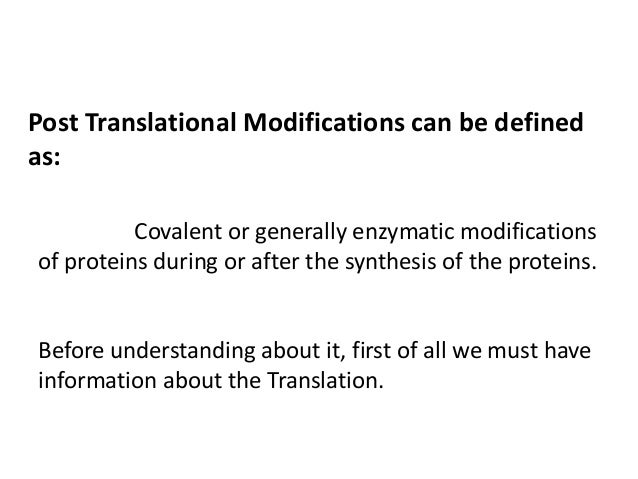 Source: slideshare.net
Source: slideshare.net
Other proteins will be glycosylated - a sugar will be added. Youll find the correct answer below. Click card to see definition. Another common post-translational modification is cleavage or linking of parts of the protein itself. Initiation Peptide bond formation Phosphorylation Elongation The Correct Answer is Phosphorylation Reason Explained Phosphorylation is correct for.
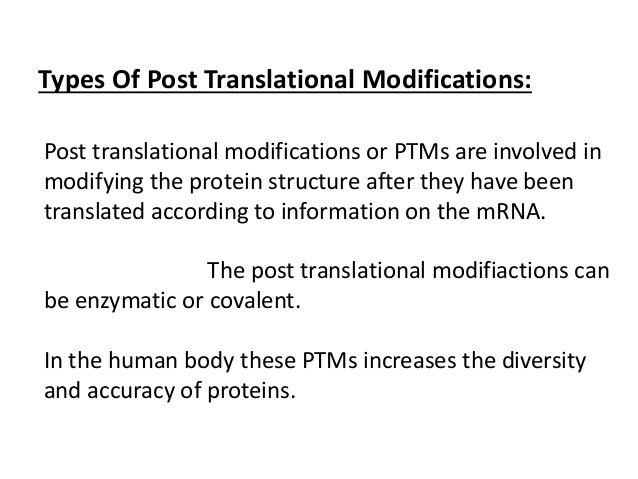 Source: slideshare.net
Source: slideshare.net
Multi-protein complex that recognizes a signal peptide and directs it to the rough ER where further translation and modification can take place. Proteins are synthesized by ribosomes translating mRNA into polypeptide chains which may then undergo PTM to form the mature protein product. Click card to see definition. Steps of post translational modification of secretory and membrane bound proteins. An activator binds to an enhancer.

Multi-protein complex that recognizes a signal peptide and directs it to the rough ER where further translation and modification can take place. Other proteins will be glycosylated - a sugar will be added. Post-translational modification PTM refers to the covalent and generally enzymatic modification of proteins following protein biosynthesisProteins are synthesized by ribosomes translating mRNA into polypeptide chains which may then undergo PTM to form the mature protein product. A proteosome recognizes a ubiquitin molecule and degrades the protein molecule to which it is attached. Which of the following is an example of posttranslational modification.
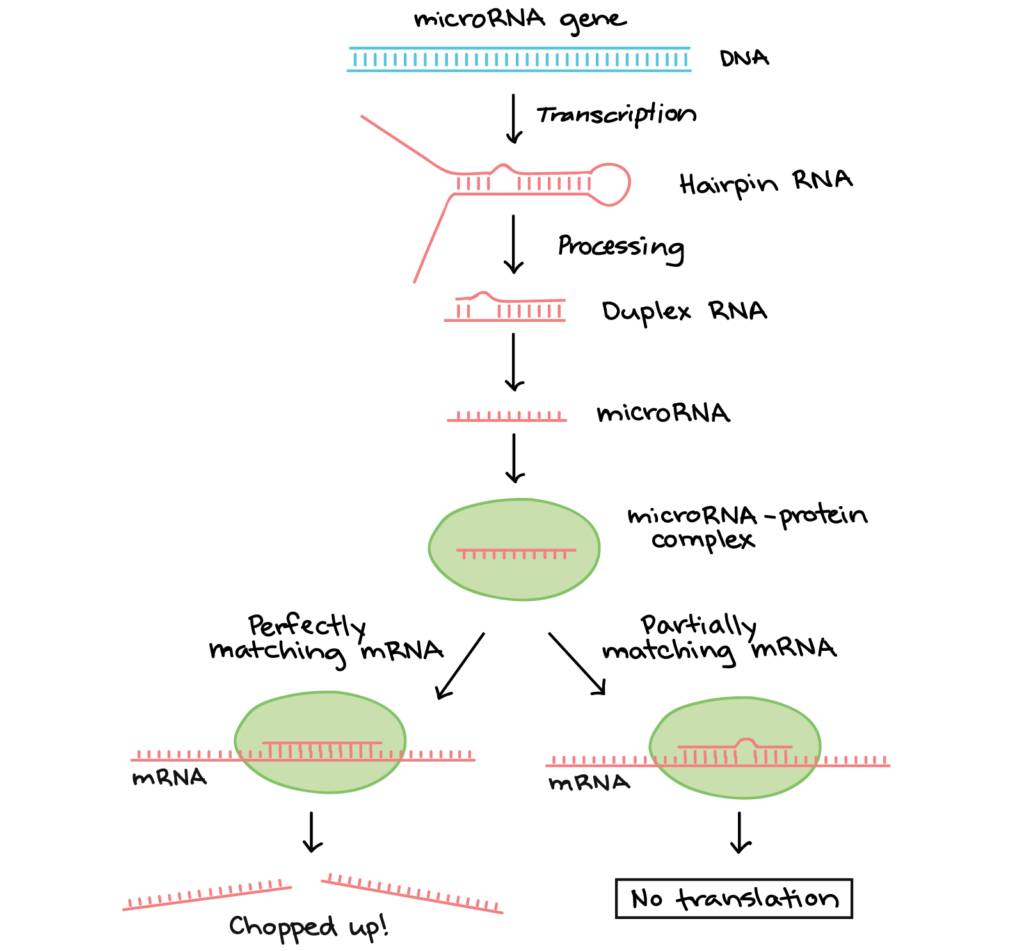 Source: courses.lumenlearning.com
Source: courses.lumenlearning.com
Post-translational modification PTM refers to the covalent and generally enzymatic modification of proteins following protein biosynthesis. Another common post-translational modification is cleavage or linking of parts of the protein itself. An activator binds to an enhancer. A proteosome recognizes a ubiquitin molecule and degrades the protein molecule to which it is attached. Which of the following processes is an example of posttranslational modification of protein.
 Source: pinterest.com
Source: pinterest.com
Which of the following processes is an example of a post-translational modification. The addition of a cap and a tail to a newly synthesized mRNA transcript. Which of the following processes is an example of a post-translational modification. Other proteins will be glycosylated - a sugar will be added. Multi-protein complex that recognizes a signal peptide and directs it to the rough ER where further translation and modification can take place.
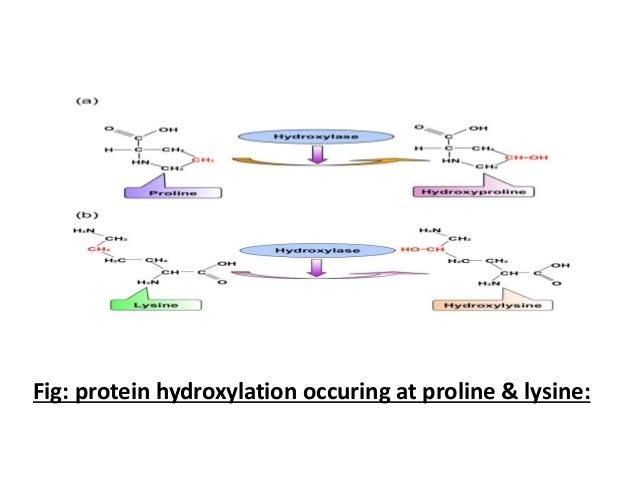 Source: slideshare.net
Source: slideshare.net
Proteolytic cleavage is one of the common modifications where proteins are cleaved to remove some additional amino acids or portion of protein. O Palmitoylation O Proteolysis Self-splicing Glycosylation QUESTION 13 Which process is not a common lipid modification to proteins. An activator binds to an enhancer. Tap card to see definition. Which of the following processes is an example of posttranslational modification of protein.
 Source: slideshare.net
Source: slideshare.net
Some proteins typically targeted to membranes will be lipidated - a lipid will be added. Youll find the correct answer below. Post-translational modification PTM refers to the covalent and generally enzymatic modification of proteins following protein biosynthesisProteins are synthesized by ribosomes translating mRNA into polypeptide chains which may then undergo PTM to form the mature protein product. Click card to see definition. Examples are zymogens which are inactive forms of enzymes and are activated by the removal of some portion of the protein.
 Source: id.pinterest.com
Source: id.pinterest.com
Common modifications include phosphate groups methyl acetate and amide groups. Youll find the correct answer below. Which of the following processes is an example of a post-translational modification. Initiation Peptide bond formation Phosphorylation Elongation The Correct Answer is Phosphorylation Reason Explained Phosphorylation is correct for. A Elongation b Initiation c Phosphorylation d Peptide bond formation.
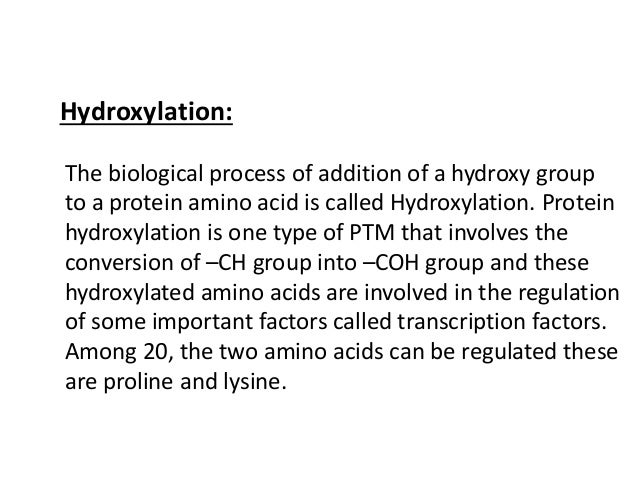 Source: slideshare.net
Source: slideshare.net
Which of the following processes is an example of a post-translational modification. Formation of disulfide bonds. Initiation Peptide bond formation Phosphorylation Elongation. A Elongation b Initiation c Phosphorylation d Peptide bond formation. PTMs are important components in cell signaling as for example when prohormones are converted to hormones.
 Source: pinterest.com
Source: pinterest.com
SRP receptor Site on the rough ER membrane that binds the SRPsynthesizing ribosome complex and moves it to a translocon gate which forces the ribosome to synthesize the rest of the protein into the lumen of the rough ER. Proteins are synthesized by ribosomes translating mRNA into polypeptide chains which may then undergo PTM to form the mature protein product. Click card to see definition. Which of the following is an example of posttranslational modification. The vast majorirtis of phosphorylation occur as a mechanism to regulate the biological activity of a protein and as such are transient.
 Source: pinterest.com
Source: pinterest.com
PTMs are important components in cell signaling as for example when prohormones are converted to hormones. The Correct Answer is. Which of the following is an example of a posttranslational control. Proteolytic cleavage is one of the common modifications where proteins are cleaved to remove some additional amino acids or portion of protein. Post-translational modification can occur at any step in the life cycle of a protein.
 Source: id.pinterest.com
Source: id.pinterest.com
Youll find the correct answer below Which of the following processes is an example of a post-translational modification. Which of the following is an example of a posttranslational control. O Palmitoylation O Proteolysis Self-splicing Glycosylation QUESTION 13 Which process is not a common lipid modification to proteins. An activator binds to an enhancer. PhosphorylationEnzymes can phosphorylate proteins to alter their activity.
 Source: pinterest.com
Source: pinterest.com
Some proteins typically targeted to membranes will be lipidated - a lipid will be added. PhosphorylationEnzymes can phosphorylate proteins to alter their activity. Which of the following processes is an example of a post-translational modification. The addition of a cap and a tail to a newly synthesized mRNA transcript. Steps of post translational modification of secretory and membrane bound proteins.
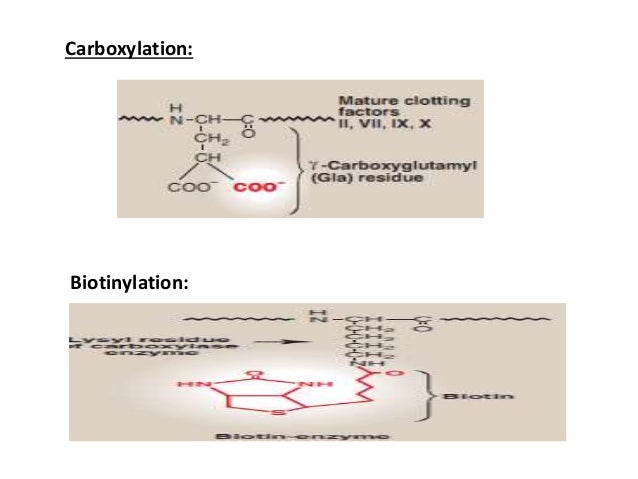 Source: slideshare.net
Source: slideshare.net
Which of the following processes is an example of posttranslational modification of protein. Post Translational Phosphorylation is one of the most common protein modifications that occur in animal cells. Examples are zymogens which are inactive forms of enzymes and are activated by the removal of some portion of the protein. A post-translational modification can be a reversible or an irreversible activity. Addition of processing of biochemical groups carbs 4.
This site is an open community for users to do submittion their favorite wallpapers on the internet, all images or pictures in this website are for personal wallpaper use only, it is stricly prohibited to use this wallpaper for commercial purposes, if you are the author and find this image is shared without your permission, please kindly raise a DMCA report to Us.
If you find this site good, please support us by sharing this posts to your preference social media accounts like Facebook, Instagram and so on or you can also bookmark this blog page with the title which of the following processes is an example of a post translational modification by using Ctrl + D for devices a laptop with a Windows operating system or Command + D for laptops with an Apple operating system. If you use a smartphone, you can also use the drawer menu of the browser you are using. Whether it’s a Windows, Mac, iOS or Android operating system, you will still be able to bookmark this website.





